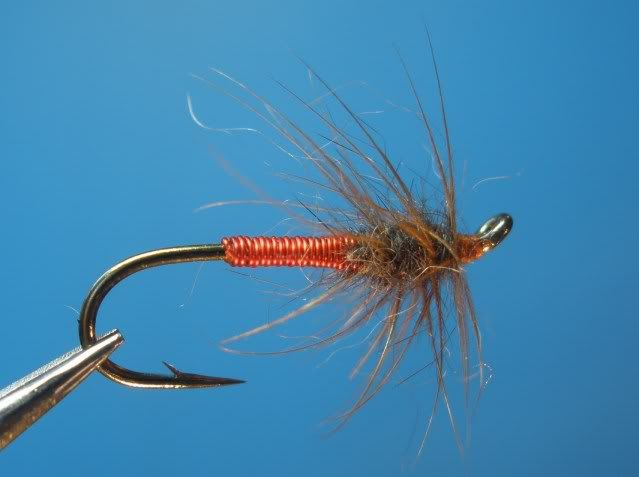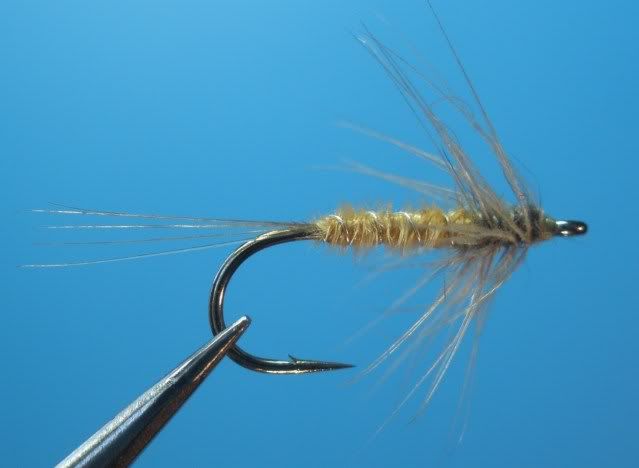Moderators: letumgo, William Anderson
-
William Anderson
- Site Admin
- Posts: 4569
- Joined: Mon Feb 23, 2009 3:14 pm
- Location: Ashburn, VA 20148
-
Contact:
Post
by William Anderson » Tue Mar 22, 2011 7:43 am
Another attempt at combining an attractor with something familiar.
Hook: Daiichi 1740
Body: Red Uni-wire
Hackle: Brown Hen
Thorax: Natural Mole with a pinch of beaver

w
"A man should not try to eliminate his complexes, but rather come into accord with them. They are ultimately what directs his conduct in the world." Sigmund Freud.
www.WilliamsFavorite.com
-
willowhead
- Posts: 4465
- Joined: Fri Oct 29, 2010 3:35 pm
- Location: Roscoe, N.Y./Lakeview, Arkansas
-
Contact:
Post
by willowhead » Tue Mar 22, 2011 8:32 am
Boy, these wire body flies your commin' up with are a great group of patterns. You should gather them all up in book form, and perhaps think about publishing something.....

-
tie2fish
- Posts: 5072
- Joined: Sun Feb 22, 2009 9:11 am
- Location: Harford County, MD
Post
by tie2fish » Tue Mar 22, 2011 8:39 am
That thorax/hackle work is amazing -- it looks as though the "legs" are growing right out of the body. A very realistic impression to my eye.
Some of the same morons who throw their trash around in National parks also vote. That alone would explain the state of American politics. ~ John Gierach, "Still Life with Brook Trout"
-
William Anderson
- Site Admin
- Posts: 4569
- Joined: Mon Feb 23, 2009 3:14 pm
- Location: Ashburn, VA 20148
-
Contact:
Post
by William Anderson » Tue Mar 22, 2011 8:58 am
Bill, I first saw this thorax/hackle technique about 6-7 years ago from Jim Slattery and it left quite impression. I tried really hard as a novice to get that effect back then knowing it seemed right for this type of fly (his pop-top patterns are a real benchmark).
Here is a link to Jim's pattern. Hans I hope you don't mind me posting a link to your site as a reference.
http://www.danica.com/flytier/jslattery ... flymph.htm
Here's a sulpher pattern from a couple years ago with yellow turkey flats as the body.

His flies were the goal I aspired to when I started. Luckly, I've got years left to try and get there.
w
"A man should not try to eliminate his complexes, but rather come into accord with them. They are ultimately what directs his conduct in the world." Sigmund Freud.
www.WilliamsFavorite.com
-
hankaye
- Posts: 6582
- Joined: Tue Jun 08, 2010 4:59 pm
- Location: Arrey, N.M. aka 32°52'37.63"N, 107°18'54.18"W
Post
by hankaye » Tue Mar 22, 2011 9:56 am
Dub-Ya, Howdy;
That is an amazing way to ...what would you call it Palmer the hackle thru thr thorax?
How'd ya do that?????
hank
Striving for a less complicated life since 1949...
"Every day I beat my own previous record for number
of consecutive days I've stayed alive." George Carlin
-
William Anderson
- Site Admin
- Posts: 4569
- Joined: Mon Feb 23, 2009 3:14 pm
- Location: Ashburn, VA 20148
-
Contact:
Post
by William Anderson » Tue Mar 22, 2011 10:09 am
Hank, you're exactly right. It's a common technique that dates back a long time, probably inspired from Stewart's flies (Baillie's) little soft hackles, or some of the historic midge patterns where the hackle is palmered down the body lenth. We do it with a Griffith's Gnat and others. The difference being the built up thorax on these emerger style patterns. This can be done a lot of ways, like everything else, but I strip one side of a hen hackle and bring it back through the entire thorax, which is left with soft compression in it. Then as you are going to bring your tying thread through the thorax you add a faint pinch of dub to the thread and wrap between the hackles. It keeps the hackles spread all lively and leggy. In my opinion, this makes for an improved (ducking for cover) hackle collared dry fly as well using stifffer rooster hackles instead of soft hen hackles. This is another technique to add to your growing reportiore.
w
"A man should not try to eliminate his complexes, but rather come into accord with them. They are ultimately what directs his conduct in the world." Sigmund Freud.
www.WilliamsFavorite.com
-
CreationBear
- Posts: 1156
- Joined: Sun Jun 20, 2010 6:35 pm
Post
by CreationBear » Tue Mar 22, 2011 10:45 am
It keeps the hackles spread all lively and leggy.
Great tip: I've read that a full thorax behind a traditional collared soft-hackle helps "prop up" the hackle fibers, especially in heavy current: your variation of the Hidy flymph method seems to get the same "mechanical" effects very elegantly.

(Of course, using fine dubbings like mole and beaver as you do might be a lot easier.)
A question about your wire-work, though: are you wrapping down to the hookpoint and back up on a bare shank, or is there a thread base under there?
-
William Anderson
- Site Admin
- Posts: 4569
- Joined: Mon Feb 23, 2009 3:14 pm
- Location: Ashburn, VA 20148
-
Contact:
Post
by William Anderson » Tue Mar 22, 2011 11:05 am
Thanks CB. There is a thread base and a wrap at the end just because. This one was wrapped down the wire to the bend under the thread and back up, with a touch of dub to get a swell before the thorax.
Mark (Willowhead). Thanks for the kind words. The wire bodies are something recent for me, but I saw them tied in lots of variations. I have tied a load of brassies and copper john's some time ago, but not this type. The wire tie on most of these post I first saw were by Martin Westbeek (I believe that was his name) a couple years ago. Then last year, Hans shared a barrage of wirebodied flies that I remember drowling over back then. I didn't revisit those until just a minute ago and remembered now where I saw them. Wrapping the body down to the bend, then back up as a rib was something prominent in the silk spider patterns, plastic grocery bag patterns and wire bodies. They really were remarkable.
w
"A man should not try to eliminate his complexes, but rather come into accord with them. They are ultimately what directs his conduct in the world." Sigmund Freud.
www.WilliamsFavorite.com
-
letumgo
- Site Admin
- Posts: 13342
- Joined: Sat Feb 21, 2009 7:55 pm
- Location: Buffalo, New York
-
Contact:
Post
by letumgo » Tue Mar 22, 2011 11:53 am
Wonderful stuff William, but you need to come up with a catchier name. Something like "Hotwired Hen"... (wink and a big grin emoticon)
-
hankaye
- Posts: 6582
- Joined: Tue Jun 08, 2010 4:59 pm
- Location: Arrey, N.M. aka 32°52'37.63"N, 107°18'54.18"W
Post
by hankaye » Tue Mar 22, 2011 2:59 pm
Dub-Ya, Howdy;
Still courious as to how you get the wire to NOT spin round-n-round on the hook shank. With the thread base
or if you don't use thread do ya glue in in place?
hank
Striving for a less complicated life since 1949...
"Every day I beat my own previous record for number
of consecutive days I've stayed alive." George Carlin


